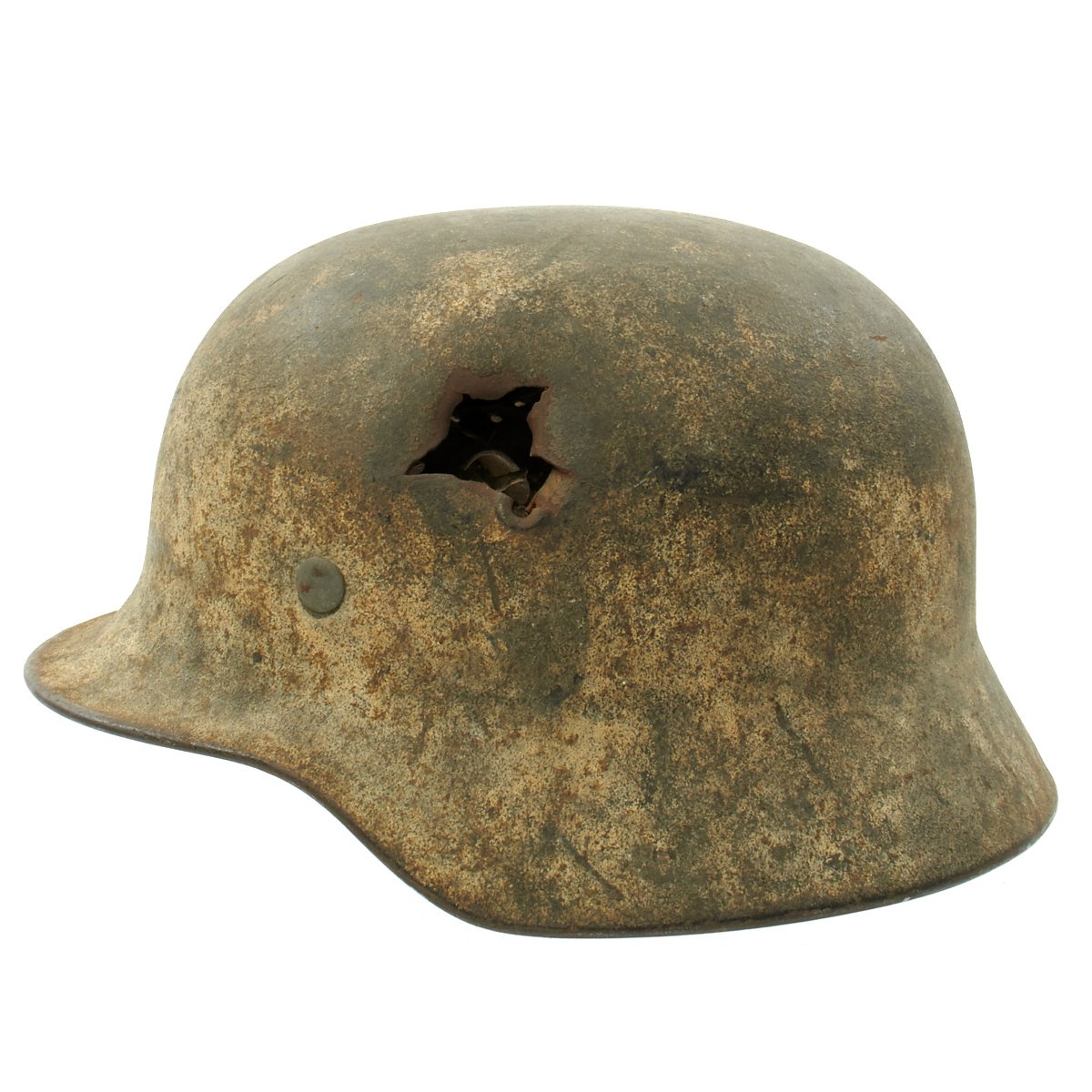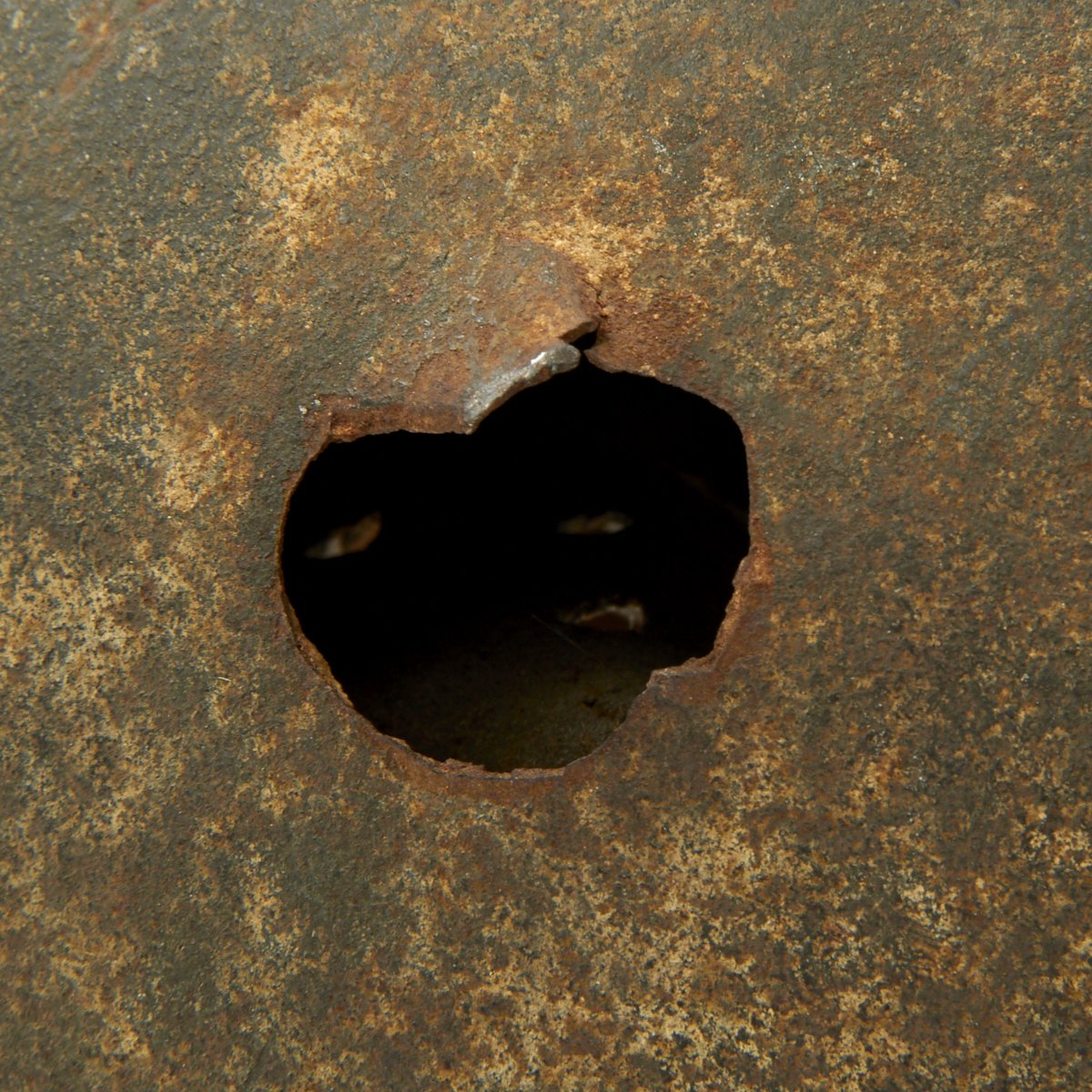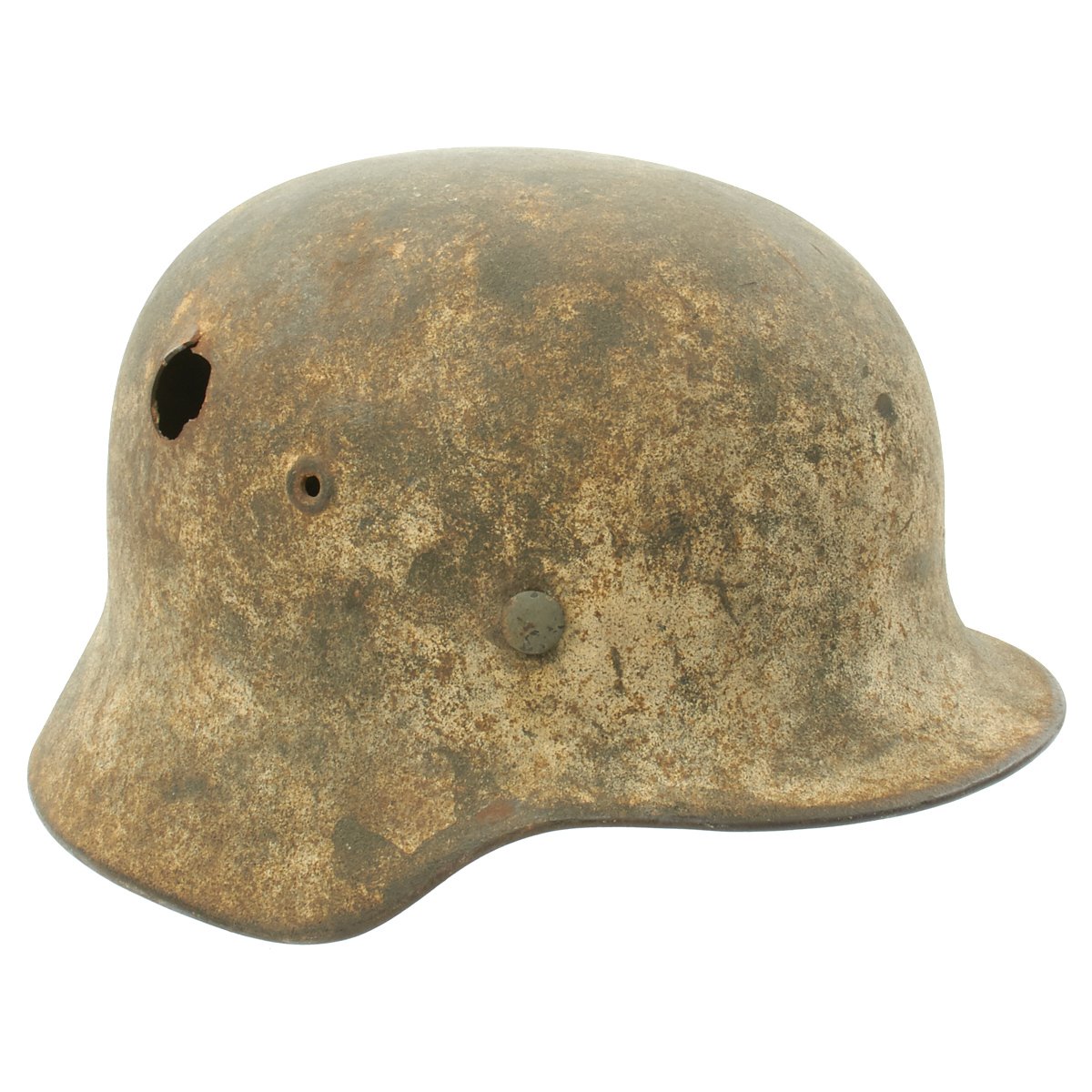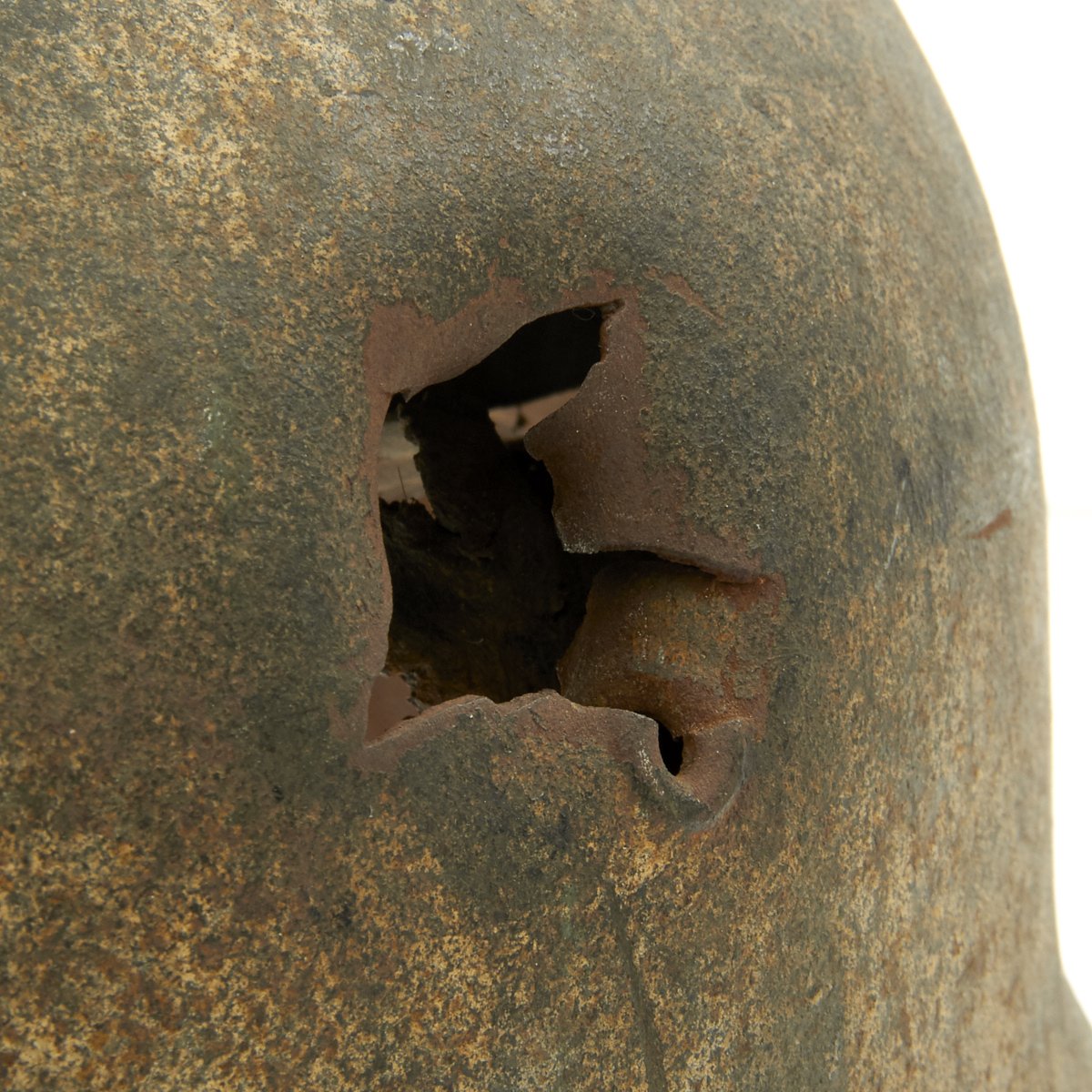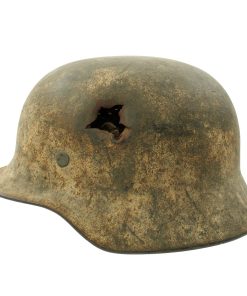Original German WWII M40 KIA Shot Through Winter Camouflage Helmet – Marked EF64 Original Items
$ 995,00 $ 248,75
Original Item: Only One Available. This is an incredible all original example Model 1940 German WWII helmet, which was originally Field Gray (FeldGrau) but was over painted with white paint for use during the winter months in snow covered theaters of operation either on the Western or Eastern front.
The unique aspects of this helmet are many; first there is a .45 caliber size bullet hole (Col 1911, Thompson SMG, M3 Grease Gun) that passes through the left side of the helmet and exits through the right. Close inspection of the paint, style and aging of the edges lead us to be very confident that this totally 100% genuine.
As with field repainted helmets, only the outside has had the white applied, most likely with a brush, as indicated by the texture. It has wear and fading, but the over paint is still over 40% complete, and the original Feldgrau paint can be seen where the white paint is worn. All three liner retaining pins are original to the helmet and intact.
The reverse, interior, neck guard apron is batch number stamped, 4071 and the interior, left side, apron has a very faded stamped manufacturer’s code and size, which appears to read EF64 indicating that Emaillierwerke AG, of Fulda, Germany manufactured it. Size 64 is a nice large size that can accommodate liners from 56cm to 58cm or US 7 to 7 1/4. Size 64 shells are harder to find and are therefore more valuable to a collector. Original chinstrap is missing.
The helmet still has its correct M31 liner, with all of the fingers still intact except for where the path of the projectile can be easily seen. The leather itself is a dark brown and stiff, due to long periods of wear, most likely in the desert heat.
Overall an incredibly rare shot through KIA 100% genuine German Winter Camouflage helmet, ready to be the talking point of any collection!
The first “modern” steel helmets were introduced by the French army in early 1915 and were shortly followed by the British army later that year. With plans on the drawing board, experimental helmets in the field, (“Gaede” helmet), and some captured French and British helmets the German army began tests for their own steel helmet at the Kummersdorf Proving Grounds in November, and in the field in December 1915. An acceptable pattern was developed and approved and production began at Eisen-und Hüttenwerke, AG Thale/Harz, (Iron and Foundry Works), in the spring of 1916.
These first modern M16 helmets evolved into the M18 helmets by the end of WWI. The M16 and M18 helmets remained in usage through-out the Weimar Reichswehr, (National Defence Force, Circa 1919-1933), era and on into the early years of the Third Reich until the development of the smaller, lighter M35 style helmet in June 1935.
In 1934 tests began on an improved Stahlhelm, whose design was a development of World War I models. The Eisenhüttenwerke company of Thale carried out prototype design and testing, with Dr. Friedrich Schwerd once again taking a hand.
The new helmet was pressed from sheets of molybdenum steel in several stages. The size of the flared visor and skirt was reduced, and the large projecting lugs for the obsolete armor shield were eliminated. The ventilator holes were retained, but were set in smaller hollow rivets mounted to the helmet’s shell. The edges of the shell were rolled over, creating a smooth edge along the helmet. Finally, a completely new leather suspension, or liner, was incorporated that greatly improved the helmet’s safety, adjustability, and comfort for each wearer. These improvements made the new M1935 helmet lighter, more compact, and more comfortable to wear than the previous designs.
The Army’s Supreme Command officially accepted the new helmet on June 25, 1935 and it was intended to replace all other helmets in service.
More than 1 million M1935 helmets were manufactured in the first two years after its introduction, and millions more were produced until 1940 when the basic design and production methods were changed, replacing the multi-piece riveted vent with one stamped directly into the steel. Later, in 1942 the rolled steel rim was removed from the pattern to further expedite production.
Fast Shipping with Professional Packaging
Thanks to our longstanding association with UPS FedEx DHL, and other major international carriers, we are able to provide a range of shipping options. Our warehouse staff is expertly trained and will wrap your products according to our exact and precise specifications. Prior to shipping, your goods will be thoroughly examined and securely secured. We ship to thousands clients each day across multiple countries. This shows how we're dedicated to be the largest retailer on the internet. Warehouses and distribution centres can be located throughout Europe as well as the USA.
Note: Orders with more than one item will be assigned a processing date depending on the item.
Before shipping before shipping, we'll conduct a thorough inspection of the items you have ordered. Today, the majority of orders will be delivered within 48 hours. The delivery time will be between 3-7 days.
Returns
The stock is dynamic and we cannot completely manage it because multiple stakeholders are involved, including our factory and warehouse. So the actual stock may alter at any time. It's possible that you may not receive your order once the order has been made.
Our policy is valid for a period of 30 days. If you don't receive the product within 30 days, we are not able to issue a refund or an exchange.
You can only return an item if it is unused and in the same state as the day you received it. You must have the item in its original packaging.
Related products
Uncategorized
Uncategorized
Uncategorized
Uncategorized
Uncategorized
Uncategorized
Armoured Fighting Vehicles of the World: AFVs of World War One (Hardcover Book) New Made Items
Uncategorized
Uncategorized
Uncategorized
Band of Brothers ORIGINAL GERMAN WWII Le. F.H. 18 10.5cm ARTILLERY PIECE Original Items
Uncategorized
Uncategorized
Uncategorized
Uncategorized
Uncategorized
